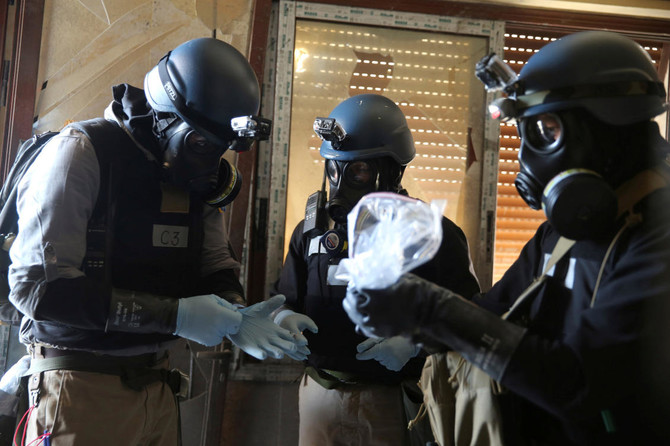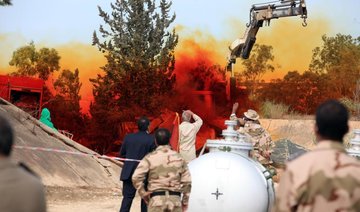WASHINGTON: The Trump administration on Thursday accused Syrian President Bashar Assad’s government of producing and using “new kinds of weapons” to deliver deadly chemicals despite committing to abolish its program in 2013, and said the world must find a way to stop it.
President Donald Trump has not ruled out additional military action to deter attacks or punish Assad, administration officials said, although they did not suggest any action was imminent. They emphasized that the United States was seeking a new way to hold chemical weapons-users accountable and wanted cooperation from Russia, Assad’s patron, in pressuring him to end the attacks.
Raising the alarm about the continued threat, US officials said it was “highly likely” that Assad kept a hidden stockpile of chemical weapons after 2013 that he failed to properly disclose. They said information gathered from recent alleged attacks also suggested that Assad retained a “continued production capacity” — also banned under the 2013 deal.
There were no indications that the Syria government, after seven years of civil war, had developed new, deadlier chemicals. Rather, the officials said they believed the weapons used to distribute the chemicals had evolved to become more sophisticated, potentially to evade international capability by making the origins of attacks harder to trace. The officials weren’t authorized to speak on the record and briefed reporters on condition of anonymity.
More recent attacks have involved both chlorine, which has nonchemical uses and is easier to acquire, and the more sophisticated chemical sarin, the officials said. They said that in recent years, Assad has also adjusted his tactics to reduce the chances that attacks will be attributed to his forces.
That has made evidence-collection more difficult, though the US believes it has a firm understanding of the extent of chemical use in Syria through a combination of intelligence, sample testing by third countries, and social media and other open-source information, the officials said.
Assad’s government has denied using chemical weapons, and its chief ally, Russia, has claimed that the reports are false attempts to pressure Syria’s government or provocations perpetrated by opposition groups. Syria and Russia have dismissed the conclusions of the Joint Investigative Mission, an expert body set up by the set up by the United Nations and Organization for the Prohibition of Chemical Weapons, that determined Assad’s government used chlorine gas in 2014 and 2015, and sarin in April 2017.
Use of such widely deplored weapons comes with great risk for Assad, raising questions about why he would take the chance. But the officials said the US believes Assad’s government sees chemical attacks as an effective way to terrorize rebels and sympathetic populations into fleeing, therefore altering the demographic balance in the Alawite heartland where Assad is trying to consolidate control.
Yet Syria’s government isn’t the only chemical weapons threat in the region, according to the officials. Daesh continue to use them, they said, although the militants’ arms are said to be more rudimentary.
Though Daesh no longer controls large parts of Syria or Iraq, the officials said the extremist group continues to use sulfur mustard, via artillery shells, and chlorine, delivered by improvised explosive devices. The officials noted that the underlying chemicals are easy to acquire or produce, and said the US does not believe Daesh has gotten ahold of military stockpiles in either Iraq or Syria.
Years of efforts by two US presidents have failed to end the harrowing reports on chemical weapons use in Syria.
Under President Barack Obama, the United States stopped short of striking Assad’s forces in response, but brokered a deal with Russia to rid Syria of its stockpiles. After another alleged attack in April 2017, President Donald Trump ordered a retaliatory missile strike, but 10 months later, the US and international observers say the weapons are still used.
Reports of chemical attacks have continued to stream in from Syria, including as recently as Thursday, when rescue workers in the rebel-held Damascus suburb of Douma reported what they described as a suspected chlorine gas attack that injured a number of civilians. The opposition-run Ghouta Media Center reported in a posting on its Facebook page that three people were killed and dozens suffered shortness of breath as a result of surface to surface missiles, some of them carrying chlorine gas.
The reports could not be independently verified and the Britain-based Syrian Observatory for Human Rights, which monitors the war in Syria via activists on the ground, was unable to confirm the reports either. The accounts followed a suspected attack in late January near Damascus that activists and rescue teams said affected nearly 20 civilians.
US says Syria may be making new types of chemical weapons
US says Syria may be making new types of chemical weapons

Israel fires mortar into Gaza residential area, wounding at least 10

- The attack is the latest Israeli attack since the Oct. 10 ceasefire took effect
- Palestinian health officials have reported over 370 deaths from Israeli fire since the truce
JERUSALEM: Israeli troops fired a mortar shell over the ceasefire line into a Palestinian residential area in the Gaza Strip, in the latest incident to rock the tenuous ceasefire with Hamas. Health officials said at least 10 people were wounded, and the army said it was investigating.
The military said the mortar was fired during an operation in the area of the “Yellow Line,” which was drawn in the ceasefire agreement and divides the Israeli-held majority of Gaza from the rest of the territory.
The military did not say what troops were doing or whether they had crossed the line. It said the mortar had veered from its intended target, which it did not specify.
Fadel Naeem, director of Al-Ahli Hospital, said the hospital received 10 people wounded in the strike on central Gaza City, some critically.
It was not the first time since the ceasefire took effect on Oct. 10 that Israeli fire has caused Palestinian casualties outside the Yellow Line. Palestinian health officials have reported over 370 deaths from Israeli fire since the truce.
Israel has said it has opened fire in response to Hamas violations, and says most of those killed have been Hamas militants. But an Israeli military official, speaking on condition of anonymity in line with military protocol, said the army is aware of a number of incidents where civilians were killed, including young children and a family traveling in a van.
Palestinians say civilians have been killed in some cases because the line is poorly marked. Israeli troops have been laying down yellow blocks to delineate it, but in some areas the blocks have not yet been placed.
Ceasefire’s next phase
The Israel-Hamas ceasefire is struggling to reach its next phase, with both sides accusing each other of violations. The first phase involved the exchange of hostages for Palestinian prisoners. The second is supposed to involve the deployment of an international stabilization force, a technocratic governing body for Gaza, the disarmament of Hamas and further Israeli troop withdrawals from the territory.
The remains of one hostage, Ran Gvili, are still in Gaza, and the militants appear to be struggling to find it. Israel is demanding the return of Gvili’s remains before moving to the second phase.
Hamas is calling for more international pressure on Israel to open key border crossings, cease deadly strikes and allow more aid into the strip. Recently released Israeli military figures suggest it hasn’t met the ceasefire stipulation of allowing 600 trucks of aid into Gaza a day, though Israel disputes that finding.
Humanitarian groups say the lack of aid has had harsh effects on most of Gaza’s residents. Food remains scarce as the territory struggles to bounce back from famine, which affected parts of Gaza during the war.
The toll of war
The vast majority of Gaza’s 2 million people have been displaced. Most live in vast tent camps or among the shells of damaged buildings.
The initial Hamas-led Oct. 7, 2023, attack on southern Israel killed around 1,200 people and took 251 hostages. Almost all hostages or their remains have been returned in ceasefires or other deals.
Israel’s two-year campaign in Gaza has killed more than 70,660 Palestinians, roughly half of them women and children, according to the territory’s Health Ministry, which does not distinguish between militants and civilians in its count. The ministry, which operates under the Hamas-run government, is staffed by medical professionals and maintains detailed records viewed as generally reliable by the international community.














